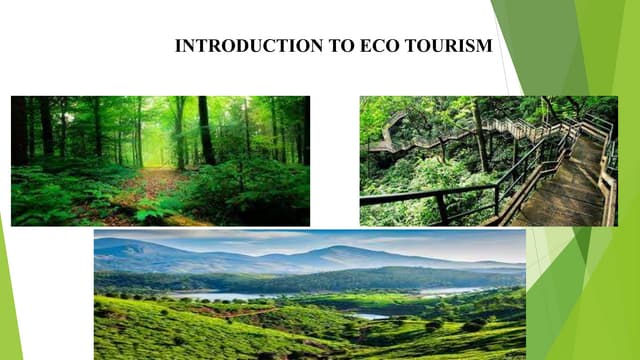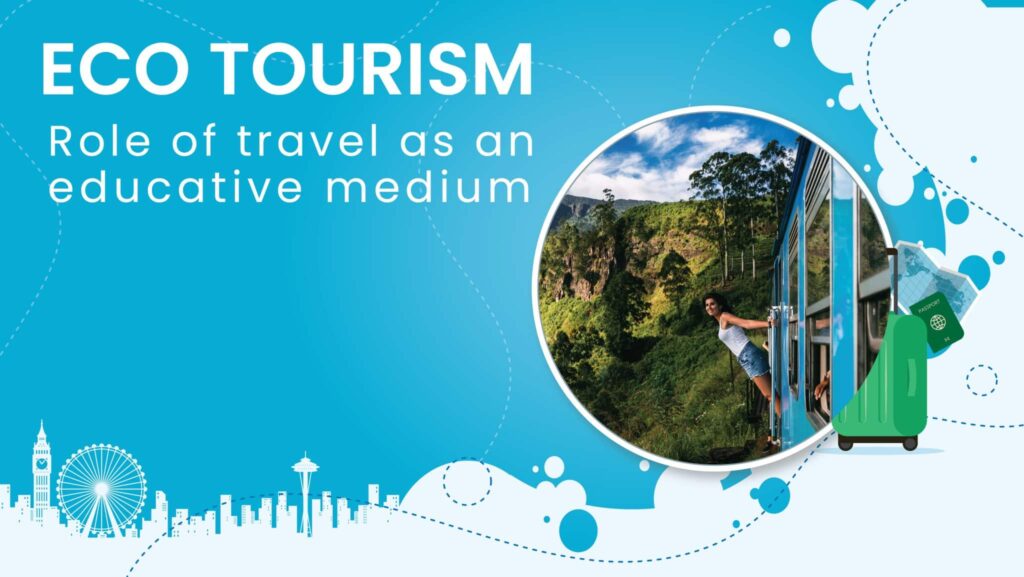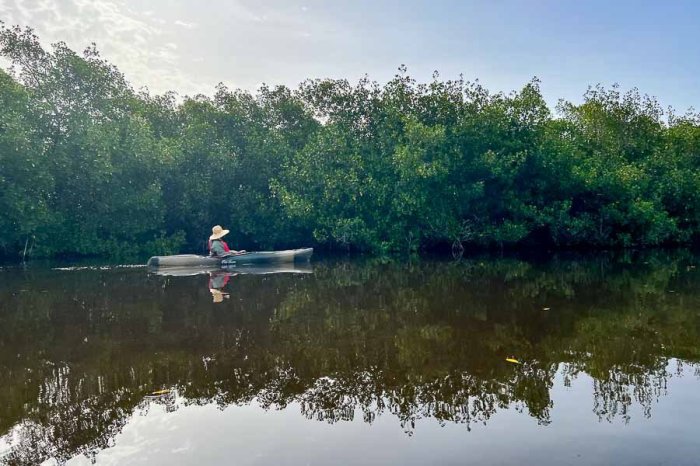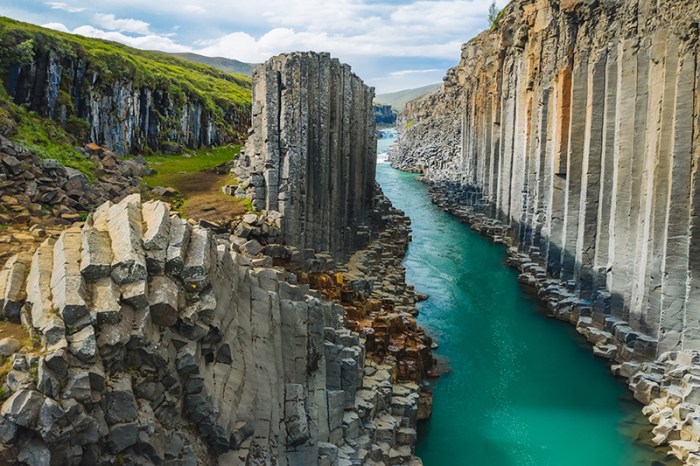Eco Tourism Destinations Unveiling Sustainable Wonders
Eco tourism destinations offer a unique blend of adventure and conservation. These destinations, carefully crafted to minimize environmental impact, provide visitors with immersive experiences while supporting local communities and preserving natural beauty. From wildlife reserves to sustainable villages, a diverse array of options caters to various interests. This exploration will delve into the key characteristics, sustainable practices, and visitor experiences within these remarkable locations.
Eco-tourism destinations are characterized by their commitment to environmental responsibility. They prioritize minimizing their footprint, supporting local communities, and fostering a deeper appreciation for the natural world. This approach distinguishes them from traditional tourist destinations, creating a more meaningful and sustainable travel experience for all involved.
Introduction to Eco-Tourism Destinations

Eco-tourism destinations are areas specifically designed to promote responsible travel and recreation while minimizing environmental impact. They prioritize the preservation of natural resources and cultural heritage, offering visitors an immersive experience that respects the local environment and communities. This approach distinguishes them from traditional tourist destinations, which often focus primarily on maximizing economic gain with less consideration for the long-term sustainability of the location.
Eco-tourism destinations are characterized by a unique blend of natural beauty, cultural richness, and a strong commitment to environmental protection. They often feature pristine landscapes, diverse wildlife populations, and opportunities for interacting with local communities. The core principles of eco-tourism are centered around minimizing the negative consequences of tourism while maximizing its positive impact. This includes supporting local economies, preserving biodiversity, and promoting sustainable practices.
Defining Eco-Tourism Destinations
Eco-tourism destinations are distinguished by their commitment to minimizing environmental impact and maximizing positive contributions to local communities. This contrasts with traditional tourist destinations, which may prioritize profit over environmental and social well-being. Crucially, eco-tourism destinations actively seek to limit their footprint, often through the implementation of sustainable practices.
Key Characteristics of Eco-Tourism Destinations, Eco-Tourism Destinations
Eco-tourism destinations possess several key characteristics that differentiate them from traditional tourist destinations. These include a commitment to environmental conservation, cultural preservation, and economic viability for local communities.
- Environmental Conservation: Eco-tourism destinations prioritize the preservation of natural resources and biodiversity. This often involves working with local communities to protect natural habitats, manage wildlife populations, and promote sustainable land use practices. For example, a destination might actively support reforestation efforts or implement strict waste management systems to minimize pollution.
- Cultural Preservation: Respect for local cultures and traditions is integral to eco-tourism. Destinations often feature opportunities for visitors to interact with local communities, learn about their customs, and support local artisans and businesses. This could involve participating in cultural workshops, staying in homestays, or patronizing local markets.
- Economic Viability: Eco-tourism seeks to create economic benefits for local communities. This involves supporting local businesses, employing local people, and ensuring that the economic gains generated by tourism are distributed equitably within the community. This can take the form of local guides, homestays, and artisanal product sales.
Core Principles and Values of Eco-Tourism
Eco-tourism is underpinned by a set of core principles that emphasize environmental responsibility, cultural respect, and community empowerment.
- Minimizing Environmental Impact: Eco-tourism destinations actively seek to minimize their environmental footprint. This includes reducing waste, conserving water and energy, and promoting responsible resource use. For instance, destinations might use renewable energy sources or implement water-efficient irrigation systems.
- Supporting Local Communities: Eco-tourism prioritizes the economic well-being of local communities. This involves supporting local businesses, employing local people, and ensuring that tourism benefits are shared equitably. A common practice is to establish fair-trade relationships with local businesses.
- Promoting Cultural Understanding: Eco-tourism promotes cultural understanding and respect. This involves providing opportunities for visitors to learn about local customs, traditions, and ways of life. For example, providing cultural interpretation services or organizing workshops on local crafts.
Examples of Eco-Tourism Destinations
The following table provides examples of eco-tourism destinations, highlighting their location, unique eco-features, and sustainability practices.
| Destination Name | Location | Unique Eco-Features | Sustainability Practices |
|---|---|---|---|
| Costa Rica | Central America | Diverse ecosystems, including rainforests, coral reefs, and cloud forests, and abundant wildlife. | Protected areas, sustainable agriculture, and reforestation projects. |
| Kenya | East Africa | Vast wildlife reserves, diverse landscapes, and rich cultural heritage. | Community-based tourism initiatives, wildlife conservation programs. |
| Galapagos Islands | Ecuador | Unique endemic species, volcanic landscapes, and rich marine biodiversity. | Strict visitor limits, protected marine zones, and educational programs. |
Types of Eco-Tourism Destinations

Eco-tourism destinations offer diverse experiences, catering to various interests while minimizing environmental impact. They range from pristine wilderness areas to thoughtfully managed communities, providing opportunities for responsible exploration and appreciation of natural beauty. Understanding the different categories allows travelers to choose experiences aligned with their preferences and values.
Different eco-tourism destinations cater to various interests and levels of involvement. Some emphasize wildlife observation, others focus on cultural immersion, and still others highlight sustainable practices. The specific characteristics of each destination determine the type of experience it offers.
Wildlife Reserves
Wildlife reserves prioritize the preservation of natural habitats and the conservation of animal populations. These areas are often carefully managed to maintain biodiversity and provide safe havens for endangered species. Visitors typically engage in guided tours, wildlife viewing, and educational programs to learn about the flora and fauna. These experiences can involve hiking, birdwatching, or photographic safaris.
National Parks
National parks are large protected areas, often encompassing a variety of ecosystems. They provide opportunities for outdoor recreation, including hiking, camping, and picnicking, while also serving as vital habitats for numerous species. Visitors are often encouraged to adhere to park regulations to minimize environmental impact and ensure the sustainability of the ecosystem.
Sustainable Villages
Sustainable villages offer a unique blend of cultural immersion and environmental responsibility. These communities often integrate eco-friendly practices into their daily lives, from renewable energy to waste management. Visitors can experience local traditions, participate in workshops, and learn about sustainable living firsthand. This approach fosters a deeper connection with the local culture and its sustainable practices.
Coastal Eco-Tourism Destinations
Coastal eco-tourism destinations often encompass areas with unique marine ecosystems. These include coral reefs, mangroves, and diverse marine life. Activities commonly involve snorkeling, diving, boat tours, and educational programs about marine conservation. These destinations often highlight the importance of protecting coastal habitats and the species that depend on them.
Table: Examples of Eco-Tourism Destinations
| Destination Type | Location | Target Audience | Key Attractions |
|---|---|---|---|
| Wildlife Reserve | Serengeti National Park, Tanzania | Nature enthusiasts, wildlife photographers | The African Big Five, a diverse savanna ecosystem |
| National Park | Yosemite National Park, USA | Hikers, campers, and nature lovers | Giant sequoia trees, waterfalls, granite cliffs |
| Sustainable Village | Khao Sok National Park, Thailand | Eco-conscious travelers, cultural explorers | Sustainable agriculture, traditional crafts, and unique biodiversity |
| Coastal Eco-Tourism | Galapagos Islands, Ecuador | Divers, snorkelers, and nature enthusiasts | Unique marine wildlife, volcanic landscapes |
Sustainable Practices in Eco-Tourism
Eco-tourism, by its very nature, prioritizes environmental conservation. Sustainable practices are integral to its success, ensuring the long-term viability of both the destination and the experience for visitors. These practices encompass a wide range of initiatives, from waste management and energy conservation to community engagement and responsible resource use. Effective implementation fosters a positive ripple effect, supporting local economies and preserving natural heritage for future generations.
Eco-tourism destinations strive to minimize their environmental impact through a variety of sustainable practices. These practices are not merely optional add-ons but are fundamental components of a successful and responsible eco-tourism model. They encompass a spectrum of actions, including waste reduction, energy efficiency, water conservation, and responsible resource management.
Waste Management Strategies
Effective waste management is crucial for maintaining the pristine environment of eco-tourism destinations. Destinations often implement comprehensive waste reduction programs, incorporating recycling, composting, and proper disposal methods. The aim is to minimize landfill waste and maximize the reuse and recycling of materials. This includes educating tourists about responsible waste disposal practices.
Energy Conservation Initiatives
Energy conservation is a cornerstone of sustainable eco-tourism. Eco-friendly destinations often adopt renewable energy sources, such as solar or wind power, to reduce their reliance on fossil fuels. Energy-efficient appliances and lighting are commonly employed, minimizing energy consumption within facilities and infrastructure. Public awareness campaigns encourage visitors to adopt energy-saving behaviors.
Water Conservation Measures
Water conservation is essential for maintaining ecological balance and addressing water scarcity issues in many destinations. Eco-tourism initiatives often prioritize water-efficient fixtures and appliances in accommodations and facilities. Water-wise landscaping techniques and water harvesting systems are commonly employed. The goal is to minimize water usage and ensure the long-term availability of this vital resource.
Community Involvement and Empowerment
Local communities play a pivotal role in the success of eco-tourism. Genuine involvement ensures that the benefits of tourism are shared equitably. Empowering local communities through job creation, skill development, and fair trade practices fosters a sense of ownership and sustainability. Partnerships with local businesses and organizations are often crucial for successful community engagement.
Responsible Tourism for Resource Preservation
Responsible tourism is paramount for the preservation of natural resources. Educating tourists about the delicate ecosystems they visit is a crucial aspect of responsible tourism. Promoting respectful behavior, discouraging littering and disturbance of wildlife, and encouraging responsible consumption are crucial. This approach aims to minimize the negative impacts of tourism on fragile environments.
Comparison of Sustainable Practices
| Practice | Description | Benefits | Implementation Examples |
|---|---|---|---|
| Waste Management | Reducing, reusing, and recycling waste materials. Proper waste disposal and segregation. | Minimizes landfill waste, conserves resources, and promotes environmental cleanliness. | Implementing recycling programs, composting facilities, and designated waste disposal areas; educating tourists on responsible waste disposal. |
| Energy Conservation | Utilizing renewable energy sources like solar and wind power. Implementing energy-efficient appliances and lighting. | Reduces reliance on fossil fuels, lowers carbon footprint, and reduces energy costs. | Installing solar panels on buildings, using energy-efficient LED lighting, and promoting public transportation. |
| Water Conservation | Employing water-efficient fixtures and appliances. Implementing water-wise landscaping techniques. | Conserves water resources, reduces water bills, and protects water quality. | Installing low-flow showerheads and toilets, using drought-resistant plants, and implementing water harvesting systems. |
Visitor Experiences at Eco-Tourism Destinations

Source: ask.com
Eco-tourism destinations strive to offer enriching and memorable experiences for visitors while simultaneously promoting environmental conservation and local communities. These experiences go beyond mere sightseeing, encompassing a deeper engagement with nature, culture, and the surrounding environment. Visitors are encouraged to actively participate in activities that foster understanding and respect for the destination’s unique characteristics.
Visitors to eco-tourism destinations often find themselves immersed in a diverse range of activities, creating a sense of connection with the environment and the local culture. These experiences not only enhance personal well-being but also contribute to the preservation of the destination’s delicate ecosystems.
Types of Experiences Offered
Eco-tourism destinations offer a wide array of experiences tailored to different interests. These range from wildlife viewing and nature walks to cultural immersion and community engagement programs. Visitors can participate in activities like birdwatching tours, guided hikes through scenic trails, or even learn traditional crafts from local artisans.
Benefits for Visitors
Eco-tourism provides numerous benefits for visitors beyond the thrill of adventure. It promotes personal growth by fostering a deeper appreciation for the natural world. Participants develop environmental awareness, understanding the interconnectedness of ecosystems and the importance of conservation. Furthermore, eco-tourism often facilitates cultural exchange, enabling visitors to learn about local traditions, customs, and ways of life. This exchange can lead to a more profound understanding and appreciation of diverse cultures.
Contribution to Destination Preservation
Eco-tourism activities, when implemented responsibly, play a crucial role in preserving the destination’s natural beauty. Activities that prioritize sustainability minimize environmental impact. Guided tours and responsible wildlife viewing practices, for example, help protect sensitive ecosystems and promote respectful interactions with local wildlife. Additionally, by supporting local communities through eco-tourism, visitors help sustain livelihoods and encourage sustainable practices that benefit both people and the environment.
Visitor Activities and Sustainable Practices
- Wildlife Viewing: Guided tours and educational programs are designed to minimize disturbance to wildlife. Strict guidelines about maintaining a safe distance and avoiding feeding animals are implemented to protect their well-being. Educational materials about the animals and their habitats are often provided to enhance visitor understanding and appreciation.
- Nature Walks and Hikes: Designated trails are maintained and monitored to prevent erosion and habitat damage. Waste management systems are in place to ensure minimal litter and pollution. Interpretive signs and guides provide insights into the local flora and fauna, promoting responsible interaction with nature.
- Cultural Immersion: Visitors are encouraged to participate in respectful interactions with local communities. Support for local businesses and crafts, as well as engagement with local cultural events, are designed to foster a mutually beneficial relationship.
- Community-Based Activities: Eco-tourism often supports local communities by providing employment opportunities and income generation. Many destinations offer opportunities to participate in local activities, such as cooking classes, farming experiences, or craft workshops, which provide a deeper understanding of local culture and support the local economy.
Challenges and Opportunities for Eco-Tourism Destinations: Eco-Tourism Destinations

Eco-tourism, while offering a sustainable approach to travel, faces numerous challenges. These challenges often stem from the very nature of tourism, which can strain resources and negatively impact local communities if not managed carefully. Conversely, eco-tourism presents significant opportunities for economic growth and environmental preservation, especially when implemented thoughtfully and with community involvement.
Understanding these challenges and embracing the opportunities is crucial for the long-term success and sustainability of eco-tourism destinations. Successful eco-tourism strategies must address issues of overtourism, infrastructure limitations, and community concerns, while simultaneously fostering innovation and economic benefits for local populations.
Overtourism andItss Impacts
Overcrowding at eco-tourism destinations can lead to resource depletion, environmental damage, and a negative visitor experience. This can result in strained infrastructure, decreased biodiversity, and increased pollution. For example, popular hiking trails in national parks often suffer from overuse, leading to erosion and damage to vegetation. Likewise, excessive visitor numbers at coastal eco-tourism sites can impact marine ecosystems and disrupt local communities.
Infrastructure Limitations
Eco-tourism destinations frequently face limitations in infrastructure, such as inadequate transportation, accommodation, and sanitation facilities. This can compromise the visitor experience and hinder the overall development of the eco-tourism sector. Limited access to clean water and proper waste disposal systems can have a significant impact on the environment and local health.
Community Concerns and Engagement
Local communities often have concerns regarding the economic benefits of eco-tourism. While the sector has the potential to create jobs and generate income, the benefits may not always be distributed equitably or sustainably. This lack of equity can lead to conflicts between tourists and locals, and potentially affect the long-term success of the eco-tourism destination. Therefore, the inclusive participation of local communities in the planning and management of eco-tourism initiatives is essential. Strategies for equitable distribution of benefits and addressing concerns are crucial.
Opportunities for Future Development and Innovation
Innovative approaches can mitigate the negative impacts of tourism and enhance the economic benefits for local communities. For example, the development of sustainable transportation options, such as electric vehicles and eco-friendly shuttles, can minimize the environmental footprint. Likewise, promoting responsible tourism practices, such as waste reduction and conservation education, can foster a more sustainable visitor experience.
Strategies for Mitigating Negative Impacts
Strategies to reduce the negative impacts of tourism on eco-tourism destinations include implementing visitor quotas, promoting sustainable transportation options, and investing in eco-friendly infrastructure.
Enhancing Economic Benefits for Local Communities
Strategies for enhancing economic benefits for local communities involve supporting local businesses, ensuring fair wages and working conditions for local employees, and investing in community development projects. Developing partnerships with local communities, creating job opportunities in the eco-tourism sector, and providing training and skills development programs can be highly effective. Furthermore, supporting local crafts and cultural attractions can enhance the economic value of eco-tourism destinations.
Illustrative Case Studies
Eco-tourism destinations offer a unique opportunity to experience nature while contributing to its preservation. Successful initiatives demonstrate how responsible tourism can coexist harmoniously with environmental protection. These examples highlight innovative strategies and the importance of community involvement in fostering sustainable practices.
Understanding the diverse approaches taken by different destinations provides valuable insights into the complexities and rewards of eco-tourism development. Successful case studies often feature a strong commitment to local communities, environmentally conscious practices, and a focus on visitor experience.
Costa Rica’s Pacuare River Lodge
The Pacuare River Lodge, nestled within the pristine rainforest of Costa Rica, exemplifies a successful model of eco-tourism. Its history traces back to a recognition of the region’s ecological importance and the potential for sustainable tourism. The lodge prioritizes minimal environmental impact, employing sustainable construction practices and sourcing local materials. Visitors engage in nature walks, kayaking, and wildlife viewing, with all activities carefully managed to maintain the ecological integrity of the area. A significant aspect of the lodge’s success is its commitment to local communities, providing employment opportunities and supporting local businesses.
Tanzania’s Ngorongoro Conservation Area
Tanzania’s Ngorongoro Conservation Area, a UNESCO World Heritage Site, boasts exceptional biodiversity and a rich cultural heritage.. Ngorongoro’s eco-tourism initiatives focus on promoting responsible wildlife viewing, minimizing human impact on fragile ecosystems, and supporting local communities through income-generating projects. Strict regulations and visitor management systems are in place to ensure the protection of wildlife and natural resources. Community-based tourism projects are vital, fostering a sense of shared responsibility and generating economic benefits for local people.
The Galapagos Islands, Ecuador
The Galapagos Islands, renowned for their unique flora and fauna, have long recognized the importance of sustainable eco-tourism. The archipelago’s remarkable biodiversity and evolutionary history have made it a global treasure. Its eco-tourism initiatives emphasize the protection of endemic species and fragile ecosystems. The islands’ approach to sustainable tourism involves strict regulations on visitor numbers and activities, ensuring minimal disturbance to the delicate balance of the environment. These measures are supported by rigorous environmental monitoring and conservation efforts, ensuring the long-term protection of this unique ecosystem.
Summary Table of Case Studies
| Destination | Location | Unique Features | Sustainability Strategies |
|---|---|---|---|
| Pacuare River Lodge | Costa Rica | Pristine rainforest, focus on minimal impact | Sustainable construction, local sourcing, responsible activities, and community involvement |
| Ngorongoro Conservation Area | Tanzania | The iconic Ngorongoro Crater, with high biodiversity | Responsible wildlife viewing, visitor management, and community-based tourism |
| Galapagos Islands | Ecuador | Unique flora and fauna, evolutionary history | Strict visitor regulations, environmental monitoring, and conservation efforts |
Conclusive Thoughts
By combining responsible tourism practices with captivating experiences, these destinations offer a compelling path toward sustainable travel. The future of eco-tourism hinges on continued innovation, community engagement, and responsible visitor behavior. Ultimately, these destinations inspire a greater understanding and appreciation for our planet and its diverse ecosystems.





